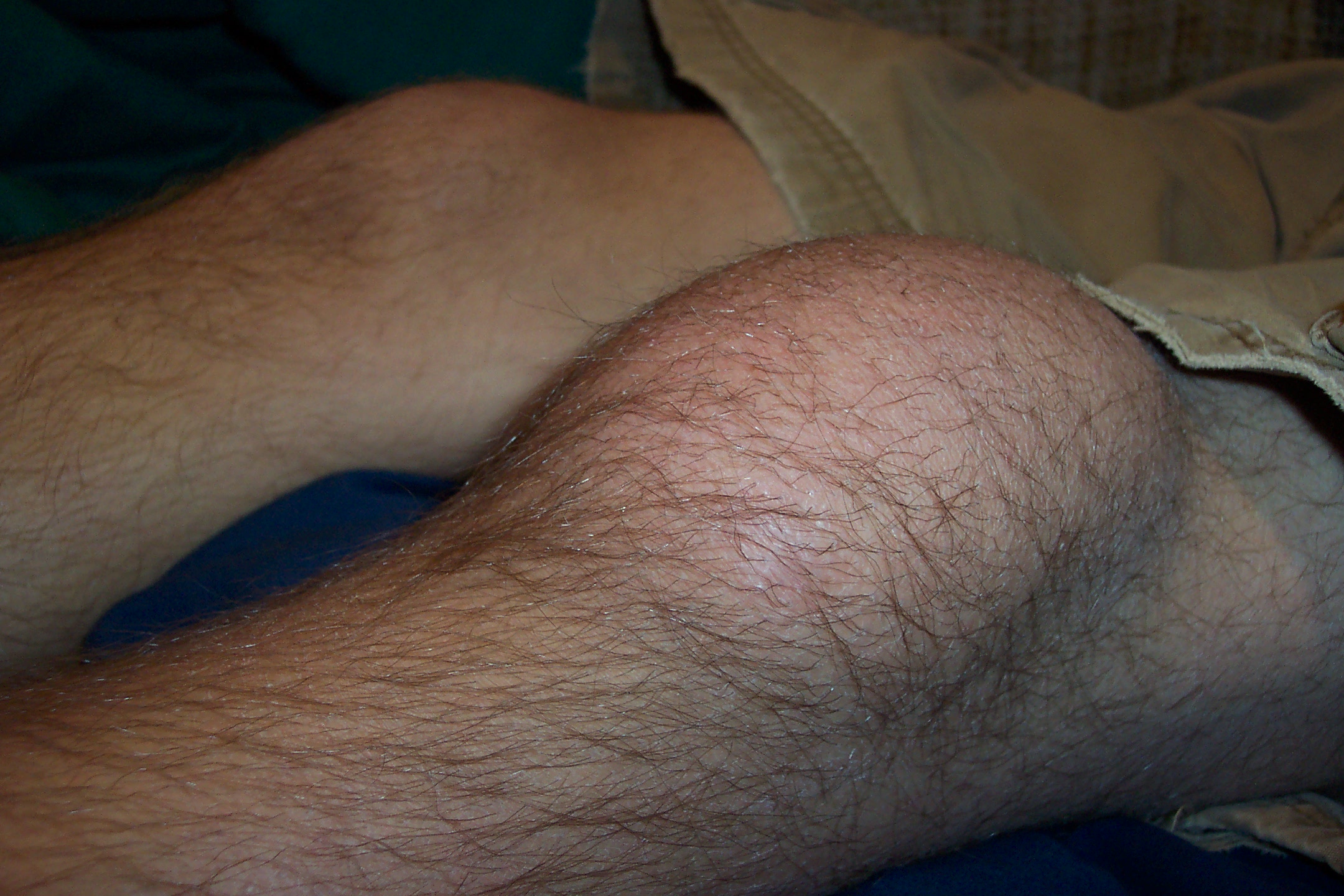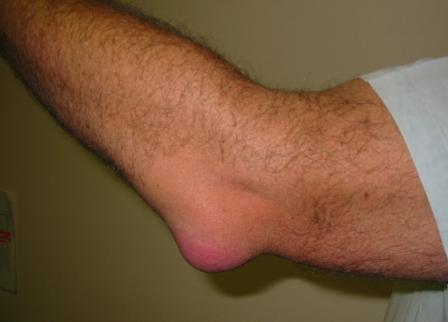Bursitis overview
|
Bursitis Microchapters |
|
Diagnosis |
|---|
|
Treatment |
|
Case Studies |
|
Bursitis overview On the Web |
|
American Roentgen Ray Society Images of Bursitis overview |
Editor-In-Chief: C. Michael Gibson, M.S., M.D. [1]; Associate Editor(s)-in-Chief: Sara Mehrsefat, M.D. [2]
Overview
Bursitis Classification
Based on the nature of inflammation bursitis may classified into 2 subtypes: septic and aseptic. Common anatomic location include shoulder, elbow, hip, knee, and ankle. Most common bursitis subtypes include subacromial, olecranon, trochanteric, prepatellar, and retrocalcaneal. Moreover, based on the location of the bursa from the skin, bursitis may be classified into 2 subtyopes: superficial and deep. Superficial bursa are more prone to get infected with bacteria and develop septic bursitis. common location of septic bursitis include knee (prepatellar bursitis), and elbow (olecranon bursitis).[1][2][3][4]
Bursitis Pathophysiology
Bursitis is characterized by acute or chronic inflammation of a bursa and buildup of fluid in the bursa sac. A bursa is a small, fluid-filled sac that acts as a cushion between a bone and other moving parts: muscles, tendons, or skin. Over 160 bursa are found throughout the body and only few of them can cause bursitis. Aseptic bursitis can be caused by overused and repetitive injuries to the joint, abdominal bony structure and crystal deposit in the bursa. It commonly affects knee or elbow, from kneeling or leaning on the elbows longer than usual. Moreover, septic bursitis can be caused by bacterial infection of the bursa through the skin injury following repetitive trauma.[2][5][6]
Images
The following are gross and microscopic images associated with bursitis:
-
Prepatellar bursitis<ref> Wikipedia.Prepatellar bursitis. https://en.wikipedia.org/wiki/Prepatellar_bursitis#/media/File:Prepatellar_bursitis.JPG Accessed on August 25, 2016</red>
-
Olecranon bursitis<ref> Wikipedia.Prepatellar bursitis. https://en.wikipedia.org/wiki/Bursitis#/media/File:Bursitis_Elbow_WC.JPG Accessed on August 25, 2016</red>
Bursitis Cause
Aseptic bursitis is commonly caused by prolonged pressure, overuse, or strenuous activity. Elbows and knees are the most commonly affected because they are rested upon more than many parts of the body with bursae and they also get the most repetitive use. Shoulder bursitis is more commonly due to overuse of the shoulder joint and muscles. Inflammation of bursae can also be caused by other inflammatory conditions such as rheumatoid arthritis and Spondyloarthritis. Gout and pseudogoutcan also be a cause of bursitis. Common causes of septic bursitis include Staphylococcus aureus, Staphylococcus epidermidis, and Streptococcus spp.[7][8][9][10][11]
Bursitis Differential Diagnosis
Bursitis symptoms and signs are relatively non-specific. Even after detailed history and physical examination, imaging studies are often necessary to rule out other musculoskeletal conditions. Bursitis must be differentiated from tendonitis, cellulitis, osteoarthritis, ligamentous injuries, and septic arthritis.[2][3][4]
Bursitis Epidemiology and Demographics
Bursitis accounts for 400 visits per 100,000 visits to primary care clinic. The exact prevalence and incidence of bursitis is unknown.[10]
Bursitis Risk Factors
Common risk factors in the development of aseptic bursitis include diabetes, rheumatoid arthritis, osteoarthritis, gout, and pseudogout. Additionally, having a hobby or job that involves repetitive motions such as bicycling, playing baseball, gardening, or setting tiles may lead to bursitis.[10]
Bursitis Screening
Screening for bursitis is not recommended.[12]
Bursitis Natural History, Complications, and Prognosis
Bursitis is often caused by recurrent micro-trauma and overuse. Symptoms of bursitis may develop rapidly within 2 to 3 days in an acute form. It usually presents with edema, erythema, and tenderness over the involved joint. In most cases after adjustment of activities, bursitis will gradually clear within few days to weeks without. If left untreated, acute bursitis may lead to chronic bursitis which may result in cicatricial adhesions, reduced mobility, and progressive pain. With treatment and activities adjustment, septic and aseptic bursitis are associated with excellent prognosis.
Bursitis History
Complete history will help determine whether the bursitis is associated with any specific activities.[2][3][4]
Bursitis Symptoms and Physical Examination
| Type of Bursitis | Symptoms | Physical examination |
|---|---|---|
| Subacromial bursitis[3] |
|
|
| Olecranon bursitis[13][14] |
|
|
| Trochanteric bursitis[15][16] |
|
|
| Prepatellar bursitis[4][17] |
|
|
| Retrocalcaneal bursitis[2][18] |
|
|
References
- ↑ Chatra PS (2012). "Bursae around the knee joints". Indian J Radiol Imaging. 22 (1): 27–30. doi:10.4103/0971-3026.95400. PMC 3354353. PMID 22623812.
- ↑ 2.0 2.1 2.2 2.3 2.4 Fauci, Anthony S., and Carol Langford. Harrison's rheumatology. McGraw Hill Professional, 2010.
- ↑ 3.0 3.1 3.2 3.3 Walker‐Bone, Karen, et al. "Prevalence and impact of musculoskeletal disorders of the upper limb in the general population.
- ↑ 4.0 4.1 4.2 4.3 Aaron, Daniel L., et al. "Four common types of bursitis: diagnosis and management." Journal of the American Academy of Orthopaedic Surgeons 19.6 (2011): 359-367.
- ↑ Hellmann DB, Imboden JB., Jr. Musculoskeletal and immunologic disorders. In: McPhee SJ, Papadakis MA, editors. Current Medical Diagnosis & Treatment. McGraw-Hill Lange; 2010. pp. 2056–2061.
- ↑ García-Porrúa C, González-Gay MA, Ibañez D, García-País MJ (1999). "The clinical spectrum of severe septic bursitis in northwestern Spain: a 10 year study". J Rheumatol. 26 (3): 663–7. PMID 10090179.
- ↑ Walker‐Bone, Karen, et al. "Prevalence and impact of musculoskeletal disorders of the upper limb in the general population." Arthritis Care & Research 51.4 (2004): 642-651.
- ↑ Wang JP, Granlund KF, Bozzette SA, Botte MJ, Fierer J (2000). "Bursal sporotrichosis: case report and review". Clin Infect Dis. 31 (2): 615–6. doi:10.1086/313983. PMID 10987734.
- ↑ National Institute of Arthritis and Musculoskeletal and Skin disease, Bursitis. http://www.niams.nih.gov/Health_Info/Bursitis/default.asp Accessed August 25, 2016
- ↑ 10.0 10.1 10.2 McAfee JH, Smith DL (1988). "Olecranon and prepatellar bursitis. Diagnosis and treatment". West J Med. 149 (5): 607–10. PMC 1026560. PMID 3074561.
- ↑ Stell IM, Gransden WR (1998). "Simple tests for septic bursitis: comparative study". BMJ. 316 (7148): 1877. PMC 28586. PMID 9632407.
- ↑ U.S. Preventive Services Task Force http://www.uspreventiveservicestaskforce.org/BrowseRec/Search?s=bursitis Accessed on August 29, 2016
- ↑ Stell IM (1996). "Septic and non-septic olecranon bursitis in the accident and emergency department--an approach to management". J Accid Emerg Med. 13 (5): 351–3. PMC 1342774. PMID 8894865.
- ↑ Lockman L (2010). "Treating nonseptic olecranon bursitis: a 3-step technique". Can Fam Physician. 56 (11): 1157. PMC 2980436. PMID 21075998.
- ↑ Brinks A, van Rijn RM, Bohnen AM, Slee GL, Verhaar JA, Koes BW; et al. (2007). "Effect of corticosteroid injection for trochanter pain syndrome: design of a randomised clinical trial in general practice". BMC Musculoskelet Disord. 8: 95. doi:10.1186/1471-2474-8-95. PMC 2045096. PMID 17880718.
- ↑ Karpinski MR, Piggott H (1985). "Greater trochanteric pain syndrome. A report of 15 cases". J Bone Joint Surg Br. 67 (5): 762–3. PMID 4055877.
- ↑ Huang, Yu-Chih, and Wen-Lin Yeh. "Endoscopic treatment of prepatellar bursitis." International orthopaedics 35.3 (2011): 355-358.
- ↑ Lyman, Jeffrey, Paul S. Weinhold, and Louis C. Almekinders. "Strain behavior of the distal Achilles tendon implications for insertional Achilles tendinopathy." The American Journal of Sports Medicine 32.2 (2004): 457-461.

